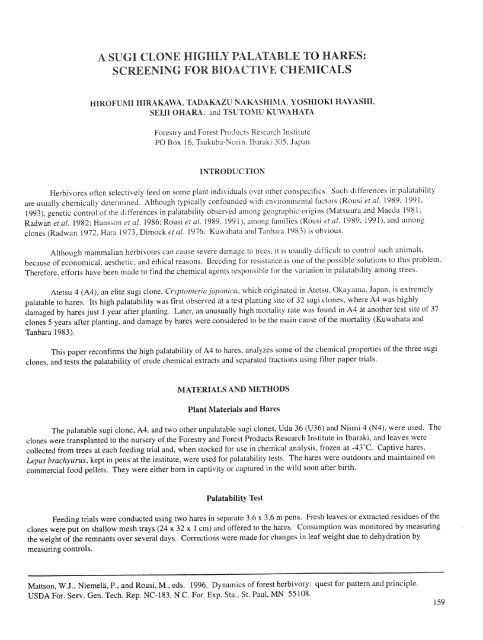View or print this publication - Northern Research Station - USDA ...
View or print this publication - Northern Research Station - USDA ...
View or print this publication - Northern Research Station - USDA ...
Create successful ePaper yourself
Turn your PDF publications into a flip-book with our unique Google optimized e-Paper software.
A SUGI CLONE HIGHLY PALATABLE TO HARES:<br />
SCREENING FOR BIOAC_IIVE CHEMICA S<br />
HIROFUMI ttlRAKAWA, TADAKAZU NAKAStIIMA, YOSttlOKI HAYASHI,<br />
SEIJI OHARA, and TSUTOMU KUWAHATA<br />
F<strong>or</strong>estry and F<strong>or</strong>est Products Resealch Institute<br />
PO Box 16, Tsukuba-N<strong>or</strong>in, Ibaraki 305, Japan<br />
INTRODUCTION<br />
Herbiv<strong>or</strong>es often selectively feed on some plant individuals over other conspecifics. Such differences in palatability<br />
are usually chemically determined. Although typically confounded with environmental fact<strong>or</strong>s (Rousi et al. 1989, 1991,<br />
1993), genetic control of the differences in palatability observed among geographic <strong>or</strong>igins (Matsuura and Maeda 1981;<br />
Radwan et al. 1982; Hansson et al. 1986; Rousi et al. 1989, 1991), among families (Rousi et al. 1989, 1991), and among<br />
clones (Radwan 1972, Hara 1973, Dimock et al. 1976, Kuwahata and Tanbara 1983) is obvious.<br />
Although mammalian herbiv<strong>or</strong>es can cause severe damage to trees, it is usually difficult to control such animals,<br />
because of economical, aesthetic, and ethical reasons. Breeding f<strong>or</strong> resistance is one of the possible solutions to <strong>this</strong> problem.<br />
Theref<strong>or</strong>e, eff<strong>or</strong>ts have been made to find the chemical agents responsible f<strong>or</strong> the variation in palatability among trees.<br />
Atetsu 4 (A4), an elite sugi clone, Cryptomeria japonica, which <strong>or</strong>iginated in Atetsu, Okayama, Japan, is extremely<br />
palatable to hares. Its high palatability was first observed at a test planting site of 32 sugi clones, where A4 was highly<br />
damaged by hares just 1 year after planting. Later, an unusually high m<strong>or</strong>tality rate was found in A4 at another test site of 37<br />
clones 5 years after planting, and damage by hares were considered to be the main cause of the m<strong>or</strong>tality (Kuwahata and<br />
Tanbara 1983).<br />
This paper reconfirms the high palatability of A4 to hares, analyzes some of the chemical properties of the three sugi<br />
clones, and tests the palatability of crude chemical extracts and separated fractions using filter paper trials.<br />
MATERIALS AND METHODS<br />
Plant Materials and Hares<br />
The palatable sugi clone, A4, and two other unpalatable sugi clones, Uda 36 (U36) and Niimi 4 (N4), were used. The<br />
clones were transplanted to the nursery of the F<strong>or</strong>estry and F<strong>or</strong>est Products <strong>Research</strong> Institute in Ibaraki, and leaves were<br />
collected from trees at each feeding trial and, when stocked f<strong>or</strong> use in chemical analysis, frozen at -43°C. Captive hares,<br />
Lepus brachyurus, kept in pens at the institute, were used f<strong>or</strong> palatability tests. The hares were outdo<strong>or</strong>s and maintained on<br />
commercial food pellets. They were either b<strong>or</strong>n in captivity <strong>or</strong> captured in the wild soon after birth.<br />
Palatability Test<br />
Feeding trials were conducted using two hares in separate 3.6 x 3.6 m pens. Fresh leaves <strong>or</strong> extracted residues of the<br />
clones were put on shallow mesh trays (24 x 32 x 1cm) and offered to the hares. Consumption was monit<strong>or</strong>ed by measuring<br />
the weight of the remnants over several days. C<strong>or</strong>rections were made f<strong>or</strong> changes in leaf weight due to dehydration by<br />
measuring controls.<br />
Mattson, W.J., Niemel_i, P., and Rousi, M., eds. 1996. Dynamics of f<strong>or</strong>est herbiv<strong>or</strong>y: quest f<strong>or</strong> pattern and principle.<br />
<strong>USDA</strong> F<strong>or</strong>. Serv. Gen. Tech. Rep. NC-183, N.C. F<strong>or</strong>. Exp. Sta., St. Paul, MN 55108.<br />
159
















